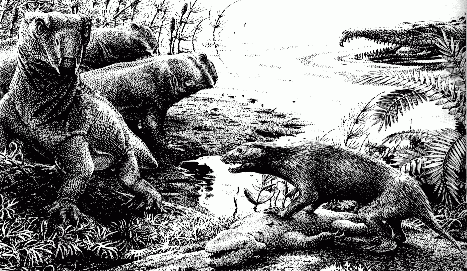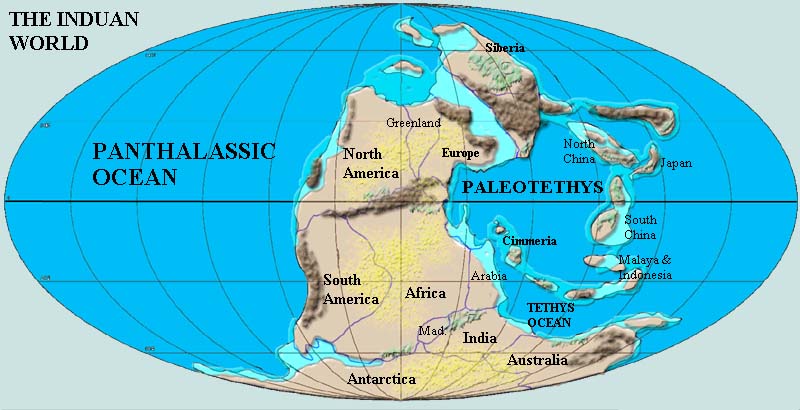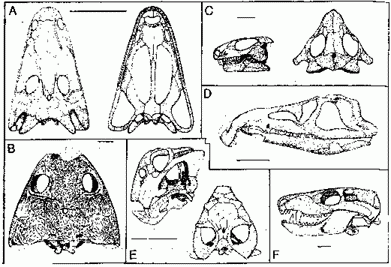
| Palaeos: Mesozoic |  |
Early Triassic |
| Triassic PERIOD | Induan - 1 |
| Page Back | Back: Changhsingian | Back: Lopingian | Up: Early Triassic | Unit Home |
| Page Next | Next: Olenekian | Next: Middle Triassic | Timescale |
During the Induan age, the survivors of the greatest disaster the Phanerozoic biosphere had faced emerged to inherit the Earth. The Mesozoic Era had begun
 |
| The drawing above shows some of the animals that were around at this time. Many of these forms had a cosmopolitan distribution. All these animals are known from the Middle Beaufort Lystrosaurus Assemblage Zone (Karoo Basin of South Africa). The herbivores were squat quadrupedal forms, belonging to the genus Lystrosaurus, an animal a little over a meter in length (above, and left on the drawing on the right). The small (about 50 cm) carnivorous and insectivorous cynodont Thrinaxodon represents a more mammalian form; one is shown here about to feed on a dead temnospondyl amphibian. The semi-aquatic Proterosuchus (1.5 metres in length) populated the rivers and streams, these resembled small crocodiles but lacked the armoured scutes (note - in this drawing the Proterosuchus appears much too large; it was only a little longer than a large Lystrosaur and a fraction the weight, and is also incorrectly shown with armour on its neck). |

The geology of the Induan is rather poorly known. There are relatively few Induan exposures, particularly for the early part of the Age. With respect to continental drift, the Induan seems to represent a brief hiatus, just before the tectonic storm that ripped Pangea apart. The great Tethys Rift had already whittled the Cimmerian lands and Southeast Asia from the Gondwanan landmass, but the Tethys Ocean remained small, and the rate of northward movement seems to have been relatively slow. The northern Siberian terranes were still accreting to the mainland, and North China and Amuria (just to the north of China) remained unconnected to Siberia.
We have indicated a continuous continental seaway separating Eurasia from Siberia, sometimes called the Meliata-Halstatt Ocean. This may be premature. However, this seaway was not a completely consistent feature and may have come and gone a number of times. Conversely, the Sundance Sea along the western continental margin of North America, is shown as a tiny indentation. It, too, came and went several times, and its size here is arbitrary.
The major geological event of the Induan, especially its earliest years, was the highly active vulcanism in Siberia and along what would become the equatorial rift separating North America and Europe from Africa and South America. Whether this caused or contributed to the end-Permian extinction is unknown, although many workers are confident that it did. Another contributing factor may have been the very low sea levels, certainly the lowest of the Mesozoic, and possibly the lowest of the entire Phanerozoic. ATW030627.
Of all the ages of the Earth, the Induan should by rights be near the top of the list of those attracting interest and investigation. This short age, a mere five million years at most (and much less according to some workers) is the first Age of the Mesozoic and occurred immediately after the greatest extinction of the Phanerozoic. Unlike the end-Cretaceous event which closed the Mesozoic, this was probably not caused by some singular catastrophe. Unlike the Verangian, Ordovician or Pleistocene Ice Ages, we cannot blame the sun or the weather or the temperature. The world itself seems to have become toxic in some as yet uncertain way.
There is very little agreement on the conditions which caused the extinction. A number of unusual conditions were present at the end of the Permian and seem to have continued well into the Induan. Not unexpectedly, we also find that the recovery of the world's animal life was also delayed until the last half of the Induan. In some areas, notably the marginal seas of Gondwana, recovery was even later. We can list these unusual factors, roughly in order of certainty, from most certain to hotly debated:
1. the climate was unusually dry, with vast areas of desert.
2. sea levels were very low.
3. the seas were anoxic. Not only was the deep sea depleted in oxygen, but even shallow waters were unaerated. For the period right around the beginning of the Induan, the oceans may have been without oxygen below 10-20m. The extent of anoxia and rate of recovery are unclear and may have varied from place to place.
4. the carbon dioxide content of the atmosphere was very high, possibly related to the vulcanism mentioned above.
5. the climate was intensely hot (or was periodically hot, or was periodically very hot, then very cold).
6. the level of atmospheric oxygen was unusually low.
7. the number of fungal spores found as microfossils was very high in at least some regions.
8. for one, or perhaps several, episodes, the stable isotope ratios of carbon and oxygen departed strongly from the norm.
9. the level of (presumably cosmic) radiation was unusually high for a relatively brief period.
Before continuing, we pause to note the interesting parallels between these conditions and, except for humidity, normal August weather in Houston, Texas. While the residents of Southeast Texas may lack the diversions provided by an active volcano system in the neighborhood, the busy refineries of Pasadena and Baytown are, happily, present to provide an equivalent injection of ever-changing organic and inorganic atmospheric spices to enliven the otherwise bland mixture of oxygen, nitrogen and inert gases on which other, less fortunate peoples are forced to subsist. Surely it is no coincidence that Houston, like Induan Earth, boasts very few dinocephalians, pareiasaurs, or Permian fauna of any kind -- at least during the summer months.
Provincial considerations aside, it remains unclear exactly what happened at the end of the Permian. Regardless of the precise causes, it would be equally interesting, and perhaps of even greater practical value, to understand how the system recovered during the early part of the Induan, in the first years of the Mesozoic. ATW030627.
|
|
(tethyal and perigondwanal) |
|
(tethyal) |
|
China |
|
|
|
|
|
|
|
|
|
|
|
|
||
|
|
|
||||
|
Griesbachian |
|
|
|
||
|
Griesbachian |
|
|
|
table based on Kozur 1998
Induan marine biotas were very impoverished, and diversity in general was low. The ammonoids survived the extinction by the skin of theior proverbial teeth, with only a couple of genera making it through.
An interesting side-effect of this was a sudden revival of microbial mats (stromatolites) to reef and shallow subtidal environments during the early Induan (not unlike the situation during the Precambrian). Quite possibly this was because the invertebrate grazers that fed on them had been almost decimated by the end Paleozoic extinction. The respite was short-lived however and they soon dissapeared.
The Permo-Trias sea level minimum and glaciation, and the associated aridity, led to diversification and dominance of the more woody and pollen-producing Gymnosperms over the Paleozoic spore-bearers. Seeds allowed them to spread into dry areas, remaining dormant until there was sufficient water for germination, while pollen allowed much wider dispersal.
Earliest Triassic tetrapod faunas are described by Dr M.A. Shiskhkin (Russian Academy of Science), as follows:
"Permo-Triassic tetrapod extinction caused by global uplifting and aridization of the land resulted in a dramatic change and, to some extent, the reversal of the above mentioned faunal structure. It may be characterized as an increasing switch of tetrapod life towards aquatic habitats. As a consequence, during the earliest Triassic (Induan), the newly arisen temnospondyl amphibian families, though still exceeded by reptiles in diversity, become fairly abundant in some cases, especially the Lydekkerinidiae in Gondwanaland and the early Capitosauridae (along with their benthosuchid offshoots) in Western Laurasia. Secondly, in contrast to latest Permian, the role of main shared component in the communities of both supercontinents was overtaken by aquatic or semi-aquatic groups, such as lydekkerinid, tupilakosaurid and long-snouted trematosaurid temnospondyls, and cosmopolitan dicynodont reptile Lystrosaurus. Except for the latter genus, the herbivorous forms completely went extinct by that time. Another peculiar feature of the Induan biota is a miniaturisation of most forms. The end of this evolutionary phase, called 'the Lystrosaurus - lydekkerinid episode' (Shishkin and Ochev 1993) appears to be marked by the replacement of primitive procolophonid reptiles (Spondylolestinae) by the more advanced Procolophoninae. This event is recorded both in South Africa and Russia and is reliably corrrelated in the latter region with the Inuan-Olenekian boundary (Shishkin et al 1996). The procolophonid evolution in both areas proceeded in parallel and gives no clear evidence of intercontinental faunal linkage. In terms of local biozonation, the discussed episode corresponds to the earliest (Tupilakosaurus) grouping of the 'Neorhachitome' Fauna in Russia and lower part of the Lystrosaurus Zone in Africa."
During this time, the world was still ruled by Therapsids. These had gained ecological dominance in lowland basins during the Middle and Late Permian, and this trend continued in the Early Triassic Lystrosaurid community type. Alongside these animals, and appearing for the first time, were the Archosaurs or "ruling reptiles", a group that was to later include dinosaurs, crocodiles, and Pterosaurs (flying reptiles or "pterodactyls"), as well as a number of other forms. Archosaurs are rare in the collections from the Lystrosaurus assemblage zone, being represented only by the aquatic crocodile-like proterosuchids and the terrestrial and lizard-like prolacertiforms. The cynodonts were all small insectivorous or carnivorous forms, which are placed in the family Galesauridae or Thrinaxodontidae.
In this earliest Triassic landscape, Thrinaxodon, the direct ancestor of mammals, and Proterosuchus, the direct ancestor of crocs, dinosaurs and birds, lived side by side, although one was terrestrial, the other semi-aquatic. As the Triassic period unfolded, the descendents of these two relatively small and early forms would vie for supremacy.
 illustration from Lucas 1998
|
| Lootsbergian index fossils: (A) Wetlugasaurus, (B) Tupilakosaurus, (C) Procolophon, (D) Proterosuchus (= Chasmatosaurus), (E) Lystrosaurus, (F) Thrinaxodon. Scale bars A, D, E are 10 cm; B and C are 1 cm. |
Dr Spencer Lucas (ref) divides Triassic tetrapod evolutionary communities into into eight land-vertebrate faunachrons (LVF). The beginning of each LVF is defined by the first appearance datum (FAD) of a widespread tetrapod genus. The first of these is Lootsbergian, which is asosciated with the cosmopolitan dicynodont Lystrosaurus. It is mostly contemporous with the Induan epoch (equivalence at least in part with the Induan is indicated by the occurrence of characteristic Lootsbergian temnospondyls in ammonite-bearing Induan strata of the Wordy Creek Formation in eastern Greenland (Trümpy, 1961), although the FAD of Lystrosaurus is actually late Permian (perhaps middle Changhsingian). According to the Russian Palaeontologist M. A. Shiskhkin (ref), Lystrosaurus ranged well into the Early Olenekian, although this dating is disputed. However, one can suggest a generic and approximate equivalence between the Lootsbergian LVF and the Induan epoch
The following is Dr Lucas' description of the Lootsbergian and listing of characteristic fauna
"Lootsbergian time begins with the FAD of the dicynodont Lystrosaurus. The end of the Lootsbergian is equivalent to the beginning of the Nonesian, which is defined by the FAD of the cynodont Cynognathus. The Lootsbergian LVF is characterized by the Lystrosaurus Assemblage Zone in the Balfour (Palingkloof Member), Katberg and Burgersdorp (lower part) formations of the Karoo basin of South Africa (Groenewald and Kitching, 1995). The following tetrapod genera are restricted to Lootsbergian time and are widespread and/or common enough to be useful as index fossils: Wetlugasaurus, Tupilakosaurus, Luzocephalus, Lydekkerina, Procolophon, Lystrosaurus, Scaloposaurus, Thrinaxodon, Proterosuchus and Prolacerta.
The terms Lystrosaurus zone, beds or fauna have been applied to a wide geographic range of strata/fossils of Lootsbergian age. The most significant vertebrate fossil assemblages of Lootsbergian age are from the upper Guodikeng and lower Jiucaiyuan formations, Junggur basin, China; Heshanggou Formation, Ordos basin, China; lower part of Fremouw Formation, Antarctica; Panchet Formation, India; Vokhmian horizon of Vetluga Series, Russian Urals; and Wordy Creek Formation, eastern Greenland."
| Page Back | Unit Home | Page Up | Page Top | Page Next |
